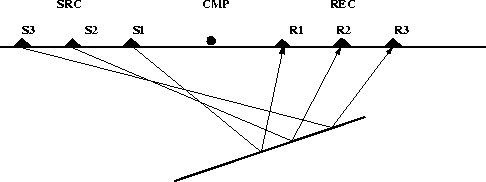|
CMPgeonodips
Figure 1 Geometry for CMP gather over a flat layer. |  |
![[*]](http://sepwww.stanford.edu/latex2html/cross_ref_motif.gif) shows the geometry of a CMP
section over a flat layer. In a CMP section,
traces are sorted so they share the same mid-point for
different locations of the source and receiver.
In this configuration when only flat layers are present,
the reflections come from a single point situated
under the CMP.
shows the geometry of a CMP
section over a flat layer. In a CMP section,
traces are sorted so they share the same mid-point for
different locations of the source and receiver.
In this configuration when only flat layers are present,
the reflections come from a single point situated
under the CMP.
|
CMPgeonodips
Figure 1 Geometry for CMP gather over a flat layer. |  |
Figure ![[*]](http://sepwww.stanford.edu/latex2html/cross_ref_motif.gif) depicts the geometry of a CMP
section over a dipping layer. In this case the reflections
do not come from the same point, but are moving
updip as the offset between source and receiver increases.
depicts the geometry of a CMP
section over a dipping layer. In this case the reflections
do not come from the same point, but are moving
updip as the offset between source and receiver increases.
The CMP Stacking assumes that reflections come from horizontal layers. Under this assumption the Normal Moveout correction (NMO) flattens the hyperbolas in a CMP gather to horizontal lines. After NMO, traces belonging to the same CMP are summed together (stacked) to enhance the reflected signal and to attenuate the noise.
|
CMPgeodips
Figure 2 Geometry for CMP gather over a dipping layer. |  |
Problems appear when multiple dipping events are present in a section.
If we combine Figures ![[*]](http://sepwww.stanford.edu/latex2html/cross_ref_motif.gif) and
and ![[*]](http://sepwww.stanford.edu/latex2html/cross_ref_motif.gif) for multiple
CMPs we obtain Figure
for multiple
CMPs we obtain Figure ![[*]](http://sepwww.stanford.edu/latex2html/cross_ref_motif.gif) a.
In Figure
a.
In Figure ![[*]](http://sepwww.stanford.edu/latex2html/cross_ref_motif.gif) a we combine the geometry in
Figures
a we combine the geometry in
Figures ![[*]](http://sepwww.stanford.edu/latex2html/cross_ref_motif.gif) and
and ![[*]](http://sepwww.stanford.edu/latex2html/cross_ref_motif.gif) for multiple Common-Mid-Points. Each
hyperbola corresponds to a CMP section over a dipping layer and a
flat layer. As the CMP moves updip, the hyperbolas corresponding
to the dipping layer appear closer to the surface while the ones corresponding to the
flat layer are unchanged.
for multiple Common-Mid-Points. Each
hyperbola corresponds to a CMP section over a dipping layer and a
flat layer. As the CMP moves updip, the hyperbolas corresponding
to the dipping layer appear closer to the surface while the ones corresponding to the
flat layer are unchanged.
A dipping reflector in a CMP
section (see Figure ![[*]](http://sepwww.stanford.edu/latex2html/cross_ref_motif.gif) a) produces a reflection hyperbola
as it will be proven later.
The NMO velocity necessary to flatten the hyperbolas
originating from reflections on the dipping
layer is higher than the real velocity.
a) produces a reflection hyperbola
as it will be proven later.
The NMO velocity necessary to flatten the hyperbolas
originating from reflections on the dipping
layer is higher than the real velocity.
Figure ![[*]](http://sepwww.stanford.edu/latex2html/cross_ref_motif.gif) a shows several CMP gathers
containing reflections from a dipping layer
and from a horizontal layer. After NMO with
the real velocity the hyperbolas corresponding
to the flat layer become straight lines (Figure
a shows several CMP gathers
containing reflections from a dipping layer
and from a horizontal layer. After NMO with
the real velocity the hyperbolas corresponding
to the flat layer become straight lines (Figure ![[*]](http://sepwww.stanford.edu/latex2html/cross_ref_motif.gif) b)
and after stacking (Figure
b)
and after stacking (Figure ![[*]](http://sepwww.stanford.edu/latex2html/cross_ref_motif.gif) c), the horizontal event is preserved
at the expense of the dipping event. In Figure
c), the horizontal event is preserved
at the expense of the dipping event. In Figure ![[*]](http://sepwww.stanford.edu/latex2html/cross_ref_motif.gif) b
NMO is performed with a higher velocity which is necessary to
flatten the hyperbolas corresponding to the dipping
event. After stacking (Figure
b
NMO is performed with a higher velocity which is necessary to
flatten the hyperbolas corresponding to the dipping
event. After stacking (Figure ![[*]](http://sepwww.stanford.edu/latex2html/cross_ref_motif.gif) c) the dipping
event is preserved at the expense of the horizontal
layer. It is obvious that the NMO correction
with a single velocity combined with CMP stacking acts as
a dip filter. The result is a degradation of the
final image when conflicting dips are present.
c) the dipping
event is preserved at the expense of the horizontal
layer. It is obvious that the NMO correction
with a single velocity combined with CMP stacking acts as
a dip filter. The result is a degradation of the
final image when conflicting dips are present.
 |
 |